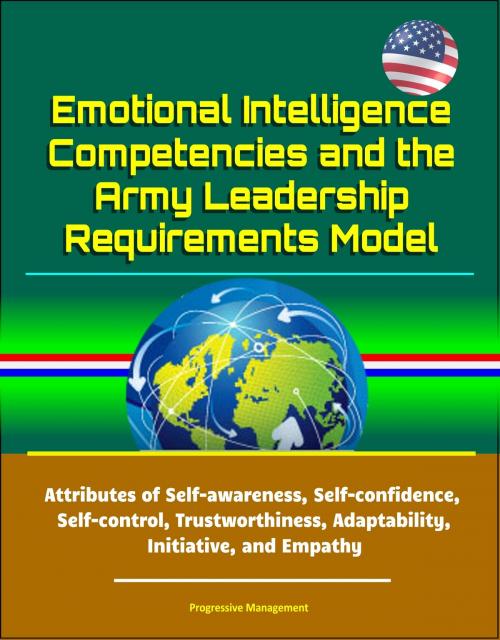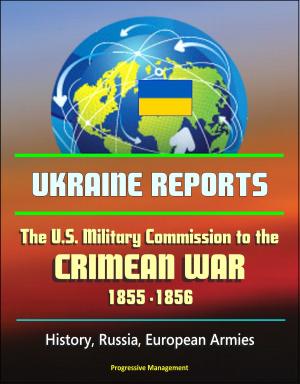Emotional Intelligence Competencies and the Army Leadership Requirements Model: Attributes of Self-awareness, Self-confidence, Self-control, Trustworthiness, Adaptability, Initiative, and Empathy
Nonfiction, Health & Well Being, Psychology, Emotions, History, Military, United States| Author: | Progressive Management | ISBN: | 9780463304723 |
| Publisher: | Progressive Management | Publication: | May 4, 2018 |
| Imprint: | Smashwords Edition | Language: | English |
| Author: | Progressive Management |
| ISBN: | 9780463304723 |
| Publisher: | Progressive Management |
| Publication: | May 4, 2018 |
| Imprint: | Smashwords Edition |
| Language: | English |
This excellent report has been professionally converted for accurate flowing-text e-book format reproduction.
Stewards of the profession and protectors of the nation, Army leaders have an immense responsibility to ensure the current and future success of the Army. This responsibility is less about the hard skills of cognitive intelligence, technical knowledge, and tactical proficiency and more about the soft skills of emotional intelligence. Emotional intelligence competencies parallel, enhance, and even enable the Army leader attributes and competencies. The Army leadership doctrine fails to identify a direct relationship between emotional intelligence competencies and the Army leader attributes and competencies, yet implies that emotional skills are an integral part of the characteristics and capabilities of an Army leader. This study examines the relationship between emotional intelligence competencies and the attributes and core competencies required of an Army leader. A clear understanding of the emotional intelligence requirements that Army leader's use in the act of leading creates a more balanced and comprehensive illustration of Army leader requirements. An understanding of the relationship between emotional intelligence and what is required of an Army leader can lead to modifications in Army leadership doctrine, leader assessments, professional Army leader development programs, and Army leader evaluation practices.
CHAPTER 1 INTRODUCTION * Background * Problem Statement * Research Question * Significance of the Study * Definition of Terms * CHAPTER 2 LITERATURE REVIEW * Background * Emotional Intelligence Models * Emotional Intelligence Competencies * Emotional Intelligence Assessments * Transformational Leadership Theory and Emotional Intelligence * Leader Behaviors and Emotional Intelligence * Leader Influence and Emotional Intelligence * Individual Performance and Emotional Intelligence * Organizational Performance and Emotional Intelligence * Summary * CHAPTER 3 RESEARCH METHODOLOGY * Overview * Epistemology * Research Design * Sample * Data Collection Methods * Data Analysis * Research Steps * Goodness and Trustworthiness * Researcher Position * Limitations * Delimitations * Summary * CHAPTER 4 ANALYSIS * Part 1: Crosswalk * Overview * Army Leader Attributes * Army Core Leader Competencies * Levels of Army Leadership * Army Leadership Requirements Model and Emotional Intelligence Crosswalk Self-awareness Competencies (Know Thy Self) * Emotional Self-awareness * Accurate Self-assessment * Self-confidence * Self-management Competencies (The Hard Right versus The Easy Wrong) * Self-control * Trustworthiness * Conscientiousness * Adaptability * Achievement Orientation * Initiative * Social Awareness Competency Cluster (Servant Leadership) * Empathy * Organizational Awareness * Service Orientation * Social Skills Competency Cluster (No Man is an Island) * Influence * Inspirational Leadership * Developing Others * Communication * Change Catalyst * Conflict Management * Building Bonds * Team Work and Collaboration * Summary * Part 2: Leadership Vignette Discussion * Vignette #1 Discussion * The Take-away * Emotional Intelligence in Action * Vignette #2 Discussion * The Take-away * Emotional Intelligence in Action * Vignette #3 Discussion * The Take-away * Emotional Intelligence Missing in Action * Summary * CHAPTER 5 CONCLUSION AND RECOMMENDATIONS * Conclusion * Recommendations * Future Research * Army Leadership Doctrine Modifications * Incorporating Emotional Intelligence Development Programs * Emotional Intelligence Leader Development Strategies * Self-awareness Development Strategies * Self-Management Development Strategies * Social Awareness Development Strategies * Social Skills Development Strategies * Summary
This excellent report has been professionally converted for accurate flowing-text e-book format reproduction.
Stewards of the profession and protectors of the nation, Army leaders have an immense responsibility to ensure the current and future success of the Army. This responsibility is less about the hard skills of cognitive intelligence, technical knowledge, and tactical proficiency and more about the soft skills of emotional intelligence. Emotional intelligence competencies parallel, enhance, and even enable the Army leader attributes and competencies. The Army leadership doctrine fails to identify a direct relationship between emotional intelligence competencies and the Army leader attributes and competencies, yet implies that emotional skills are an integral part of the characteristics and capabilities of an Army leader. This study examines the relationship between emotional intelligence competencies and the attributes and core competencies required of an Army leader. A clear understanding of the emotional intelligence requirements that Army leader's use in the act of leading creates a more balanced and comprehensive illustration of Army leader requirements. An understanding of the relationship between emotional intelligence and what is required of an Army leader can lead to modifications in Army leadership doctrine, leader assessments, professional Army leader development programs, and Army leader evaluation practices.
CHAPTER 1 INTRODUCTION * Background * Problem Statement * Research Question * Significance of the Study * Definition of Terms * CHAPTER 2 LITERATURE REVIEW * Background * Emotional Intelligence Models * Emotional Intelligence Competencies * Emotional Intelligence Assessments * Transformational Leadership Theory and Emotional Intelligence * Leader Behaviors and Emotional Intelligence * Leader Influence and Emotional Intelligence * Individual Performance and Emotional Intelligence * Organizational Performance and Emotional Intelligence * Summary * CHAPTER 3 RESEARCH METHODOLOGY * Overview * Epistemology * Research Design * Sample * Data Collection Methods * Data Analysis * Research Steps * Goodness and Trustworthiness * Researcher Position * Limitations * Delimitations * Summary * CHAPTER 4 ANALYSIS * Part 1: Crosswalk * Overview * Army Leader Attributes * Army Core Leader Competencies * Levels of Army Leadership * Army Leadership Requirements Model and Emotional Intelligence Crosswalk Self-awareness Competencies (Know Thy Self) * Emotional Self-awareness * Accurate Self-assessment * Self-confidence * Self-management Competencies (The Hard Right versus The Easy Wrong) * Self-control * Trustworthiness * Conscientiousness * Adaptability * Achievement Orientation * Initiative * Social Awareness Competency Cluster (Servant Leadership) * Empathy * Organizational Awareness * Service Orientation * Social Skills Competency Cluster (No Man is an Island) * Influence * Inspirational Leadership * Developing Others * Communication * Change Catalyst * Conflict Management * Building Bonds * Team Work and Collaboration * Summary * Part 2: Leadership Vignette Discussion * Vignette #1 Discussion * The Take-away * Emotional Intelligence in Action * Vignette #2 Discussion * The Take-away * Emotional Intelligence in Action * Vignette #3 Discussion * The Take-away * Emotional Intelligence Missing in Action * Summary * CHAPTER 5 CONCLUSION AND RECOMMENDATIONS * Conclusion * Recommendations * Future Research * Army Leadership Doctrine Modifications * Incorporating Emotional Intelligence Development Programs * Emotional Intelligence Leader Development Strategies * Self-awareness Development Strategies * Self-Management Development Strategies * Social Awareness Development Strategies * Social Skills Development Strategies * Summary















